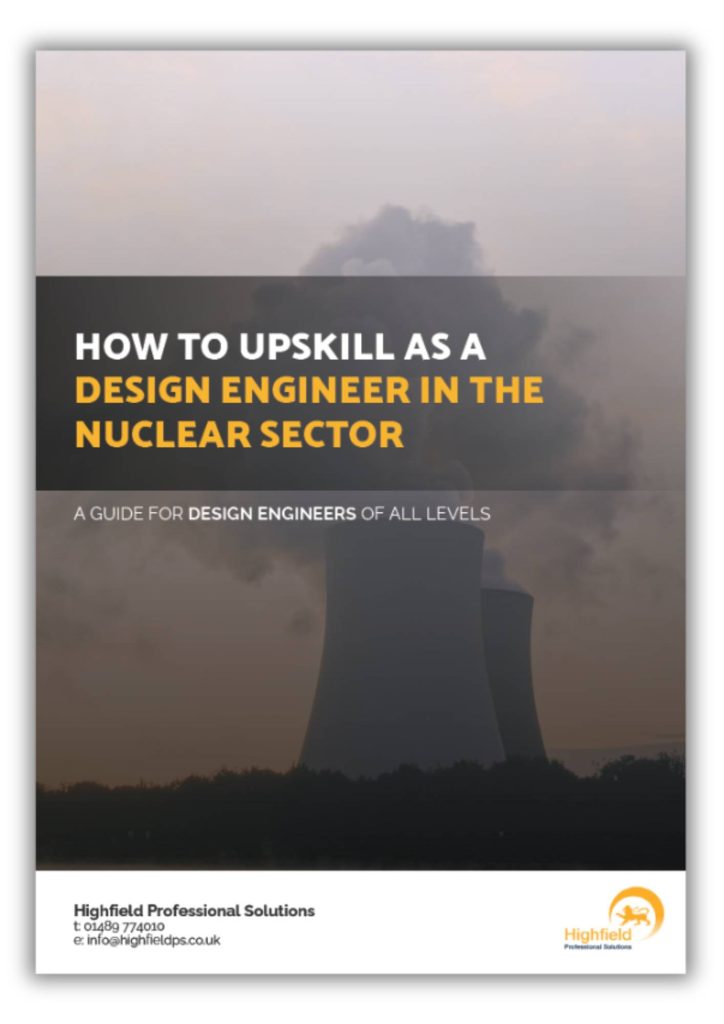8 Key Skills Design Engineers Need to Succeed in the Nuclear Sector
The UK nuclear sector is always changing in one way or another, with a range of challenges shaping the future of energy, defence, and technological advancement. As the industry tackles issues like sustainable energy production, aging infrastructure, and stringent safety regulations, the role of Design Engineers becomes increasingly crucial. These technically specialised professionals are responsible for designing the structures, systems, and components that keep nuclear facilities operational and safe.
Within the field there are various sub-disciplines, including Mechanical Design Engineers, Electrical Design Engineers, and Systems Engineers, each bringing essential expertise to the table. Their work is central to overcoming the engineering challenges associated with building, maintaining, and decommissioning nuclear power stations.
Projects in the nuclear sector are diverse, ranging from national defence initiatives, such as nuclear deterrent programs and sea-based defence systems, to civilian energy production and nuclear waste management. Design Engineers play a pivotal role in driving the nuclear sector forward, ensuring that projects are designed with precision and adhere to the high safety standards.
In this article we’ll examine key Design Engineer skills needed to work in the nuclear industry and a typical Design Engineer job description.
Design Engineer key skills
Design Engineers play a vital role in the UK nuclear industry, where their skills ensure the safety, reliability, and efficiency of systems and structures. Here are the top eight key skills required for Design Engineers to thrive in this sector:
1. 3d modelling and simulation
Proficiency in 3D modelling and simulation tools, such as AutoCAD, is essential for creating accurate representations of nuclear systems. Design Engineers use these tools to design structures, systems, and components, perform engineering calculations, and develop detailed drawings for technicians and machine operators.
Advanced software like Computer-Aided Design (CAD), Finite Element Analysis (FEA), and Computational Fluid Dynamics (CFD) is commonly employed, along with industry-specific tools such as Foran, Teamcenter, and Computer-Aided Manufacturing (CAM).
Simulation and modelling help engineers test designs under various conditions, identify potential issues early on, and optimise performance.

2. Project management
Given the complexity of projects in the nuclear sector, effective project management is a necessary skill. Design Engineers must be adept at managing timelines, coordinating with different teams, and meeting deadlines.
Techniques like Agile and Lean project management are often used to streamline processes and ensure projects remain on track. Strong organisational skills enable Design Engineers to juggle multiple responsibilities, from tracking documentation and conducting design reviews to ensuring compliance with industry regulations.
3. Organisation
The nuclear industry demands a high level of organisation, as Design Engineers must handle extensive documentation, comply with stringent regulations, and participate in design reviews. Effective organisational skills ensure that design processes run smoothly, regulatory requirements are met, and all project details are meticulously documented.
4. Collaboration
Design Engineers must work closely with multidisciplinary teams, including Nuclear Engineers, Mechanical Engineers, Civil Engineers, and Electrical Engineers.
Collaboration is essential during the design stages to integrate input from all relevant stakeholders. Beyond technical expertise, soft skills like communication and teamwork are needed to foster productive discussions and navigate complex projects involving various disciplines.
5. Problem-solving and analysis
The ability to think both creatively and analytically is critical for addressing unexpected issues in nuclear design projects. Common problems can range from design flaws to component failures, and Design Engineers must be able to quickly devise solutions.
This skill involves generating innovative concept designs, analysing engineering projects to identify areas for improvement, and implementing solutions that enhance efficiency and safety.
6. Material science
Understanding material properties is fundamental for Design Engineers working in the nuclear sector. The materials used in nuclear systems must withstand extreme conditions, such as high temperatures and radiation.
Knowledge of material science helps engineers select appropriate materials that enhance the safety and efficiency of the systems they design, ensuring components maintain structural integrity throughout their lifecycle.
7. Engineering fundamentals and technical skills
Design Engineers need a solid grasp of engineering fundamentals across various disciplines, including electrical, mechanical, and systems engineering.
For example, Electrical Design Engineer principles are vital for tasks such as circuit design and power distribution within nuclear systems, while having Mechanical Design Engineer skills ensures components can withstand high stresses. Systems thinking allows engineers to see the interconnectedness of components, enabling them to design systems that are robust, reliable, and easy to maintain.
Technical skills like performing calculations and creating assembly and disassembly procedures in accordance with engineering standards are also key to successful project execution, as is knowledge of the product life cycle.

8. Health and safety
The nuclear industry is inherently high-risk, requiring a thorough understanding of health and safety regulations. Design Engineers must strictly adhere to these regulations, conduct risk assessments, and implement safety measures to protect personnel and the environment. This involves staying up to date with safety standards and integrating health and safety considerations into every aspect of the design process.
Design Engineer job description
Here’s an example Design Engineer job description:
As a Design Engineer in the nuclear sector, you will be at the forefront of engineering innovation, working on complex projects that push the boundaries of technology. Your role will involve using advanced engineering software, including Computer-Aided Design (CAD) and Computer-Aided Engineering (CAE), to design, analyse, and optimise structures, systems, and components.
The position demands creativity, technical expertise, and collaboration with multidisciplinary teams to solve challenging engineering problems and ensure that designs meet rigorous safety and regulatory standards. As the industry evolves, you will have opportunities to integrate emerging technologies such as AI and machine learning into the design process, keeping your skills cutting-edge.
Design Engineer key responsibilities:
- Develop creative engineering solutions and innovative concept designs.
- Design structures, systems, and components using calculations and software tools.
- Create detailed drawings, specifications, and documentation for mechanical equipment.
- Conduct feasibility studies, simulations, and virtual testing to ensure performance and compliance.
- Collaborate with project teams to understand requirements and deliver technical solutions.
- Prototype, test, and refine designs to optimize functionality and production processes.
- Support manufacturing and assembly, ensuring designs meet production standards.
- Stay up-to-date with industry developments, design trends, and emerging technologies.
This role offers a dynamic environment where your skills will grow as you adapt to new challenges, ensuring the successful delivery of projects in the high-stakes nuclear industry.
Design Engineer jobs in the UK
We’re always looking for talented Design Engineers with experience working in the nuclear sector for Design Engineer jobs on industry-leading projects such as AWE, Sellafield, Hinkley Point C, Sizewell C, Devonport, and EDF Fleet.
We operate across the UK, with recent projects in the North Wales/Liverpool area. Whether you’re currently looking for a new Design Engineer job or not, we’d love to have a chat with you about the sector and your experience working in it.
The role of Design Engineers in the nuclear sector is pivotal to the industry’s continued growth and safety. As the UK faces significant challenges in energy production, defence, and technological innovation, these engineers provide the technical expertise necessary to design and maintain critical infrastructure.
By mastering key skills such as 3D modelling, project management, problem-solving, and collaboration, Design Engineers can thrive in this demanding environment. With opportunities to work on high-profile projects and integrate emerging technologies, this career path drives progress in the nuclear sector.
How to Upskill as a Design Engineer in the Nuclear Sector
Design Engineers play a crucial role in driving forward innovation, safety, and sustainability in the UK nuclear industry. But to remain at the forefront, it’s essential to continue developing your skills and knowledge. Upskilling goes beyond merely keeping pace with the industry – it’s about enhancing your technical expertise, expanding your career prospects, and building a distinctive professional brand and reputation.
Download this guide to explore what upskilling truly means for Design Engineers in the UK nuclear sector, why it’s a game-changer for your career, and seven effective strategies to make it happen.
How to Upskill as a Design Engineer in the Nuclear Sector

Looking to speak to one of our expert consultants?
Simply fill out the form below and we will get in contact with you.
"*" indicates required fields

